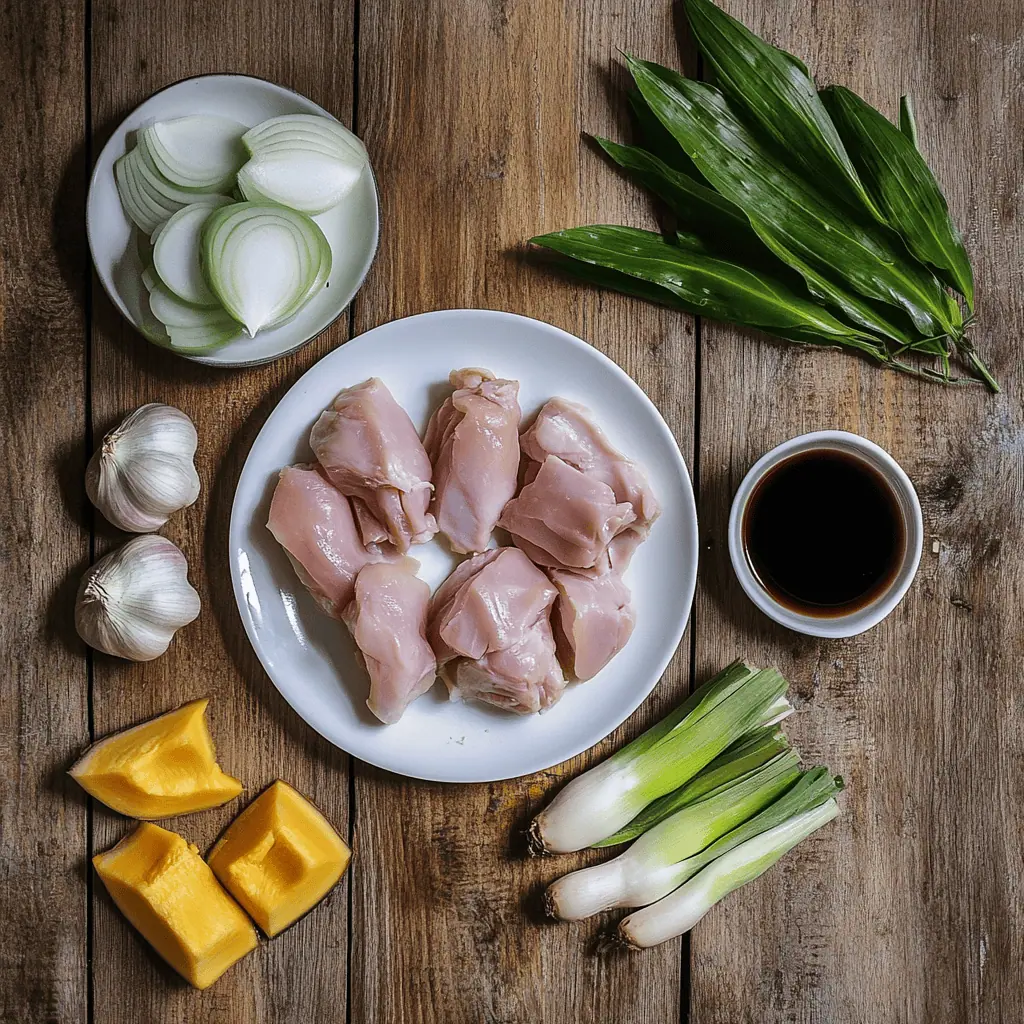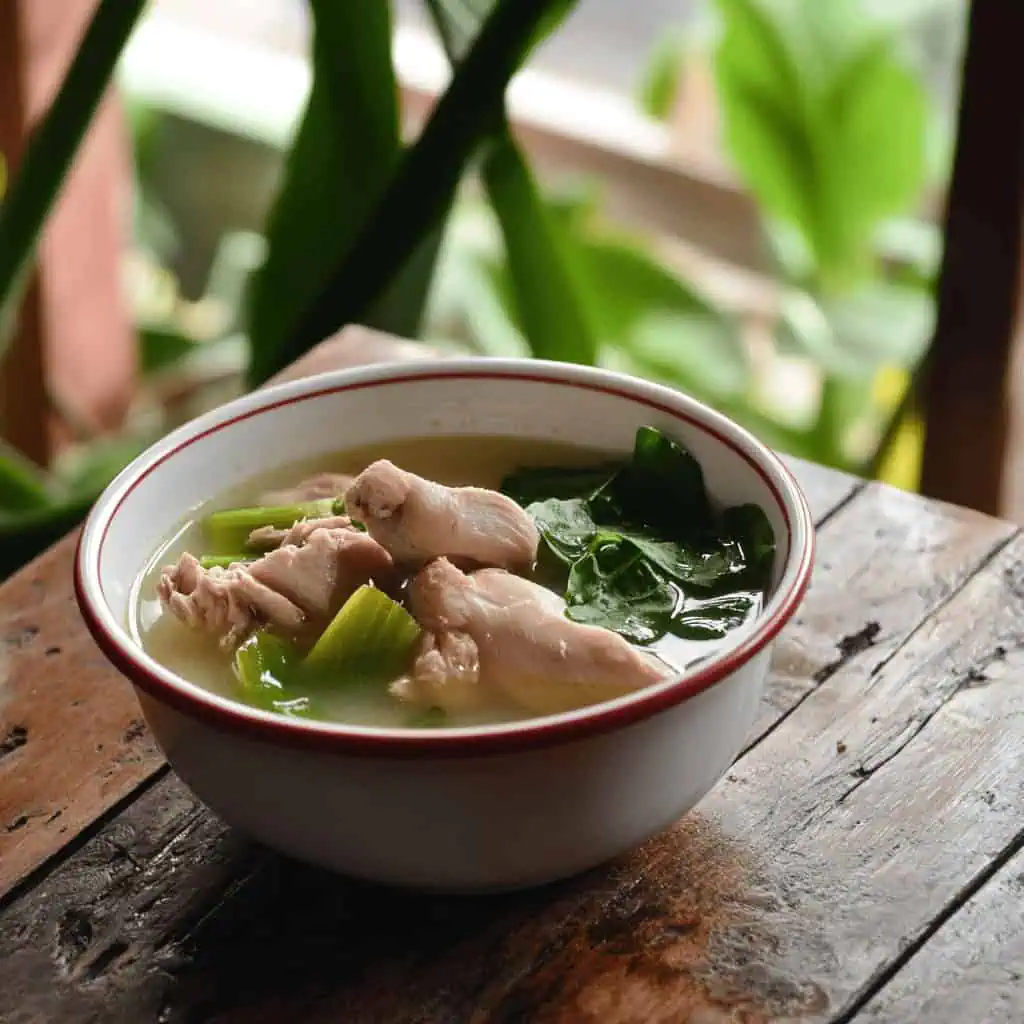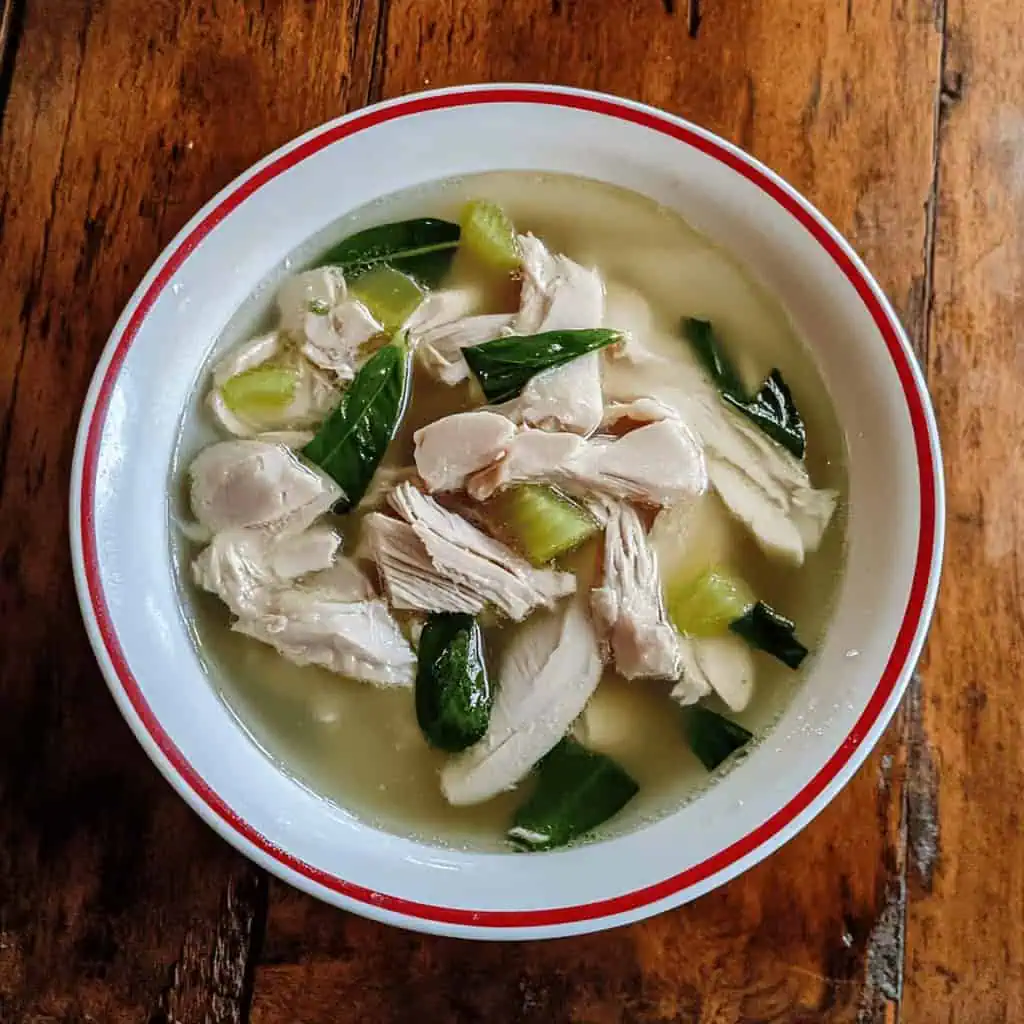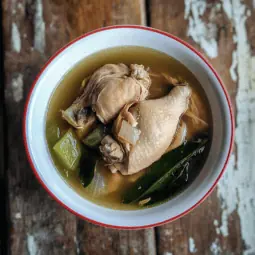There's something about walking into a kitchen filled with the aroma of ginger and chicken simmering in broth, it instantly takes me back to those sick days when my mom would make her healing Tinolang Manok.
I can still picture her, methodically slicing luya while asking "Kumain ka na ba, anak?" before serving me a steaming bowl of her tinola. This recipe is my mom's version that I've made countless times, perfected through years of phone calls asking her "Ma, tama ba 'to?"
Now whenever my own kids are feeling under the weather or when Manila's rain won't stop pouring, this soup is my go-to comfort dish. The secret? Don't rush the ginger-sautéing part - that's where all the magic starts!
With tender chicken that falls off the bone, perfectly soft papaya that soaks up all that savory broth, and malunggay leaves that make everything feel extra homey, this Tinolamg Manok recipe has been my family's cure-all for everything, from sipon to broken hearts.
Jump to:

Why You'll Love This Recipe
- Perfect Comfort Food: Soothing ginger-infused broth that's ideal for cold days or when feeling under the weather
- Authentic Flavors: Traditional recipe passed down through generations
- Nutritious: Packed with protein, vitamins, and immune-boosting ingredients
- One-Pot Meal: Easy cleanup with minimal kitchen equipment
- Budget-Friendly: Uses simple, readily available ingredients
- Make-Ahead Friendly: Tastes even better the next day
Ingredients
Each ingredient in Tinolang Manok serves a specific purpose in creating the perfect balance of flavors and textures. The chicken provides a rich protein base while bones create a flavorful broth.
Ginger isn't just for taste, it's the signature warming element that defines tinola and has natural healing properties. Green papaya adds subtle sweetness and soaks up the savory broth like a sponge, while moringa leaves or spinach add fresh color, nutrients, and a traditional finish.
This careful combination creates a nourishing soup that's both delicious and beneficial, exactly why it's been a Filipino family staple for generations.

For the Soup Base:
- Whole Chicken (3-4 lbs): Provides rich flavor and protein; native chicken (native na manok) offers the most authentic taste
- Ginger (2 thumb-sized pieces): The soul of tinola, offering warming properties and immune support
- Onion (1 small): Adds sweetness and depth to the broth
- Garlic (3 cloves): Provides immune-boosting properties and essential flavor
- Fish Sauce (2 tablespoons): Delivers umami depth and traditional Filipino flavor
- Cooking Oil (1 tablespoon): For sautéing aromatics
- Water (5 cups): The base for our broth
- Salt and Pepper: For final seasoning adjustments
Vegetables:
- Green Papaya (1 small): Adds subtle sweetness while absorbing the broth flavors
- Fresh Spinach or Moringa Leaves (1 bunch): Provides vibrant color, nutrients, and a traditional finish
- Hot Green Chilies (2-3 pieces): Optional, adds a gentle heat
Equipment
- Large Dutch Oven or Heavy Pot (5-7 quart): Allows even heat distribution for perfectly simmered soup
- Sharp Chef's Knife: For breaking down the chicken and cutting vegetables properly
- Cutting Board (preferably with juice groove): Prevents cross-contamination when handling raw chicken
- Wooden Spoon or Heat-Resistant Spatula: For stirring without scratching your pot
- Skimmer or Fine Mesh Strainer: Helps remove scum for a clearer broth
- Meat Thermometer: Ensures chicken reaches safe internal temperature (165°F/74°C)
- Kitchen Shears: Makes cutting chicken into pieces easier
- Large Ladle: For serving the soup without spills
- Soup Bowls: Deep bowls retain heat and allow proper portion of broth-to-ingredients

How To Make
- Prepare Your Ingredients
- Cut chicken into serving pieces (8-10 pieces total)
- Julienne ginger into thin matchsticks (this exposes more surface area for flavor)
- Thinly slice onion and mince garlic
- Cut green papaya into 2-inch wedges, removing seeds
- Wash spinach or moringa leaves thoroughly
- Create The Aromatic Base (15 minutes)
- Heat oil in your Dutch oven over medium heat
- Add julienned ginger and cook for 2-3 minutes until fragrant
- Key Technique: Don't rush this step! The ginger infusion is what gives tinola its signature flavor
- Add sliced onions and minced garlic, cooking until translucent (3-4 minutes)
- Develop The Chicken Flavor (10 minutes)
- Add chicken pieces to the pot, browning slightly on all sides (5-7 minutes)
- Pour in fish sauce and cook for 1-2 minutes to develop umami depth
- Chef's Tip: Use bone-in, skin-on chicken pieces for the richest broth
- Create The Soup Base (30-35 minutes)
- Add 5 cups of water and bring to a boil
- Reduce heat to maintain a gentle simmer
- Cover and cook for 30-35 minutes until chicken is tender
- Skim off any scum that rises to the surface every 10 minutes for a clearer broth
- Incorporate Vegetables (5-7 minutes)
- Add papaya wedges and cook for 3-5 minutes until tender but still holding shape
- Season with salt and pepper to taste
- Add green chilies if using
- Timing Tip: Papaya should be fork-tender but not mushy
- Finish With Greens (1-2 minutes)
- Add moringa leaves or spinach and cook just until wilted (1-2 minutes)
- Important: Don't overcook the greens as they can become too soft and lose nutrients
- Final Check and Serve
- Your Tinolang Manok is ready when:
- Broth is clear and golden with small beads of oil on top
- Chicken is fall-off-the-bone tender
- Papaya is soft but intact
- Greens are just wilted
- Serve hot with steamed rice and additional fish sauce on the side
- Your Tinolang Manok is ready when:

Tips from Lola's Kitchen
- The Ginger Secret: The key to authentic tinola is properly sautéing the ginger until fragrant before adding other ingredients. This step should never be rushed.
- Chicken Selection: While conventional chicken works fine, native chicken (native na manok) creates a more authentic flavor and firmer texture. If using conventional chicken, reduce cooking time slightly.
- Broth Clarity: For restaurant-quality clear broth, blanch the chicken pieces in boiling water for 2 minutes, then rinse before proceeding with the recipe.
- Flavor Development: Let the finished soup rest for 15-20 minutes before serving. This allows flavors to fully develop and meld together.
- Vegetable Timing: The order of adding vegetables matters. Papaya needs time to cook and absorb flavor, while greens should cook minimally to preserve nutrients and color.
- Regional Adaptations: Feel free to incorporate elements from different Filipino regions: Visayan lemongrass, Northern Luzon sayote, or Southern Tagalog pepper leaves can all create delicious variations.
- Serving Tradition: In traditional Filipino homes, the chicken neck and back are often given to elders as a sign of respect, while the chicken liver goes to the youngest child.
Substitutions
Protein Options:
- Turkey: Use turkey pieces for a different flavor profile
- Cornish Hen: Creates a more delicate version of the soup
- Bone-in Chicken Thighs: If you prefer dark meat only
- Vegetarian Option: Use vegetable broth and add firm tofu in the last 10 minutes
Vegetable Alternatives:
- Green Papaya Substitutes:
- Chayote (sayote): Provides similar texture with a milder flavor
- Bottle Gourd (upo): Creates a softer texture in the soup
- Potatoes: Offers heartier consistency, though not traditional
- Winter Melon (kundol): Gives a refreshing quality to the broth
- Leafy Green Options:
- Moringa Leaves (malunggay): Traditional and highly nutritious
- Spinach: Readily available alternative
- Chili Leaves (dahon ng sili): Adds a unique flavor dimension
- Watercress: Provides a peppery note to the soup
Troubleshooting
Cloudy Broth
- Problem: Broth lacks clarity and appears milky
- Solution:
- Blanch chicken first: Submerge in boiling water for 2 minutes, drain, then rinse before starting recipe
- Maintain gentle simmer rather than rolling boil
- Skim surface diligently during first 15 minutes of cooking
Tough Chicken
- Problem: Chicken doesn't reach fall-off-the-bone tenderness
- Solution:
- Ensure slow, steady simmering at low heat
- Extend cooking time by 10-15 minutes if needed
- Cut chicken into smaller pieces for faster cooking
- Use younger chicken for naturally tender meat
Bitter Papaya
- Problem: Green papaya has an unpleasant bitter taste
- Solution:
- Choose younger, pale green papaya without yellow spots
- Remove all seeds and inner membrane thoroughly
- Salt and rinse papaya pieces before adding to soup
- Don't overcook the papaya (keep it at 3-5 minutes)
Bland Flavor
- Problem: Soup lacks depth and tastes watery
- Solution:
- Increase ginger amount and ensure proper sautéing time
- Use bone-in chicken pieces for richer broth
- Consider adding chicken bouillon if needed
- Check fish sauce quality - it should have deep amber color
Greens Turn Brown
- Problem: Spinach or moringa leaves discolor in the soup
- Solution:
- Add greens only at the very end of cooking
- Cook just until wilted (1-2 minutes maximum)
- Add greens directly to serving bowls and pour hot soup over them
Storage & Reheating
Refrigerator Storage
- Cool soup completely before refrigerating (within 2 hours of cooking)
- Store in airtight containers for up to 3 days
- Pro tip: Store broth and solids separately; this prevents vegetables from becoming mushy
Freezer Storage
- Freeze in portion-sized containers for up to 2 months
- Leave 1-inch headspace for expansion
- Label with date and contents
- Best practice: Freeze without leafy greens and add fresh ones when reheating
Reheating Guidelines
- Stovetop: Warm slowly over medium-low heat until internal temperature reaches 165°F (74°C)
- Microwave: Use 70% power in 1-minute intervals, stirring between each
- Add fresh greens to the reheated soup just before serving
- If soup thickens during storage, add a small amount of water or chicken broth

FAQ
What does "Tinolang Manok" mean?
"Tinola" refers to the cooking method of stewing in ginger broth, while "Manok" means chicken in Filipino.
Is Tinolang Manok healthy?
Yes, it's packed with protein, vitamins, and immune-boosting ingredients like ginger and garlic. It's also relatively low in calories while being nutrient-dense.
Can I make Tinolang Manok ahead of time?
Yes, but add the greens only when reheating. The flavor actually improves after a day in the refrigerator as the ingredients meld together.
How do I know when my chicken is fully cooked?
The internal temperature should reach 165°F (74°C). The meat should easily pull away from the bone, and no pink should remain.
Can I use chicken breast instead of a whole chicken?
You can, but the broth won't be as flavorful. If using breasts, add 1-2 chicken bouillon cubes to enhance the broth.
I can't find green papaya. What else can I use?
Chayote (sayote), bottle gourd (upo), winter melon (kundol), or even potatoes make good substitutes.
What if I can't find moringa leaves?
Spinach, chili leaves, or watercress are excellent alternatives that are more widely available.
Is fish sauce necessary? I'm allergic to fish.
You can substitute with light soy sauce or coconut aminos, though the flavor profile will be slightly different. Adjust salt accordingly.
Is this recipe keto-friendly?
Yes, without the papaya and rice. The basic chicken ginger broth with greens fits well in a ketogenic diet.
How can I make this recipe more low-calorie?
Use skinless chicken pieces, skim excess fat from the broth, and serve without rice.
Can I make this vegetarian?
You can create a vegetarian version using vegetable broth, extra firm tofu, and the same vegetables and seasonings. Add 1-2 tablespoons of nutritional yeast for umami flavor.
Is Tinolang Manok gluten-free?
The basic recipe is gluten-free, but check your fish sauce brand as some may contain trace gluten.
Related
Looking for other recipes like this? Try these:

Tinolang Manok (Filipino Chicken Ginger Soup)
Ingredients
For the Soup Base:
- 1 whole chicken 3-4 lbs, cut into serving pieces (Manok na hinati-hati)
- 2 thumb-sized ginger Luya, julienned
- 1 small onion Sibuyas, thinly sliced
- 3 cloves garlic Bawang, minced
- 2 tablespoons fish sauce Patis
- 1 tablespoon cooking oil
- 5 cups water
- Salt and pepper to taste
Vegetables:
- 1 small green papaya Papaya, cut into 2-inch wedges
- 1 bunch fresh spinach Espinaca or moringa leaves (Malunggay)
- 2-3 pieces hot green chilies Siling Haba - optional
Instructions
- Start by gathering all your ingredients and cutting your chicken into serving pieces (ihanda ang lahat ng sangkap at hiwain ang manok). Set your stove to medium heat (katamtamang init) and place a large pot or Dutch oven over the heat. Pour in one tablespoon of cooking oil and allow it to warm up.
- Once the oil is hot, add your julienned ginger (luya). Let it cook for 2-3 minutes until the kitchen fills with its aroma. This step is crucial for developing the soup's signature flavor, so don't rush it (huwag madaliin ang paggisa ng luya). The ginger should become fragrant and slightly softened.
- Add your sliced onions and minced garlic to the pot. Cook them with the ginger until the onions become translucent and soft, about 3-4 minutes. Stir occasionally to prevent any burning.
- Now add your chicken pieces to the pot. Cook them for 5-7 minutes, turning occasionally, until they're lightly browned on all sides (hanggang magkaroon ng bahagyang kulay). The chicken's internal temperature should reach 165°F/74°C for food safety.
- Pour in two tablespoons of fish sauce (patis) and let it cook for 1-2 minutes. This develops a deeper flavor (para lumalalim ang lasa). Add 5 cups of water and bring the mixture to a boil at 212°F/100°C (pakuluin).
- Once boiling, lower the heat to maintain a gentle simmer (pahinain ang apoy). Cover the pot and let it cook for 30-35 minutes, or until the chicken is tender enough that it easily pulls away from the bone (hanggang lumambot ang manok). Occasionally skim off any scum that rises to the surface (alisin ang bumubulang mantika sa ibabaw).
- Add your papaya wedges to the pot. Cook them for 3-5 minutes until they're tender but still hold their shape (hanggang lumambot ang papaya pero hindi masyadong malambot). Test with a fork – it should pierce easily but not fall apart.
- Taste your broth and season with salt and pepper as needed (timplahan ng asin at paminta). The soup should be flavorful but not too salty, as diners can add more fish sauce at the table.
- Finally, add your moringa leaves or spinach (malunggay) to the pot. Let them cook just until they wilt, about 1-2 minutes. Don't overcook the greens as they can become too soft (huwag lutuin ng matagal ang dahon).
- Your Tinolang Manok is ready when the broth is clear and golden with small beads of oil on top, the chicken is fall-off-the-bone tender, the papaya is soft but intact, and the greens are just wilted. Serve hot with steamed rice and additional fish sauce on the side (ihain ng mainit kasama ng kanin at patis).
- To store, let the soup cool completely then transfer to an airtight container. It will keep in the refrigerator for up to three days (maitatago sa ref ng tatlong araw). When reheating, do so slowly over medium heat until the internal temperature reaches 165°F/74°C. Add fresh greens if needed, as they don't reheat well.
Tips from Lola's Kitchen
- Always use native chicken (native na manok) for the most authentic flavor
- Don't skip the ginger - it's the soul of tinola
- Scrape off scum as it boils for a clearer broth
- Keep the heat low after boiling to prevent the meat from toughening
- Add the greens last to maintain their nutrients
Nutrition
The Story Behind Tinolang Manok (Filipino Chicken Ginger Soup)
Walking into any Filipino household on a rainy afternoon, you might catch the aromatic symphony of ginger, garlic, and chicken wafting through the air – the unmistakable signature of Tinolang Manok simmering on the stove. This beloved chicken soup, with its clear, golden broth and tender meat, tells a story that stretches back through generations of Filipino culinary history, earning its place as one of the Philippines' most cherished comfort foods.
Long before it graced modern Filipino tables, Tinolang Manok played a pivotal role in Philippine literature and social commentary. The dish famously appeared in José Rizal's 1887 novel "Noli Me Tangere," where a scene featuring tinola became a powerful metaphor for social class divisions during the Spanish colonial period. In the novel, the serving of specific parts of the chicken to different guests highlighted the complex social hierarchies of the time – a testament to how deeply this dish was woven into Filipino cultural fabric.
The origins of tinola can be traced to pre-colonial Philippines, where early Filipinos developed a sophisticated understanding of cooking with native ingredients. The incorporation of ginger (luya) wasn't just for flavor – it reflected our ancestors' deep knowledge of food as medicine. Traditional healers, or albularyo, would often recommend ginger-based soups like tinola for various ailments, a practice that continues in many Filipino households today.
What makes Tinolang Manok particularly special is its ingenious combination of ingredients. The marriage of native chicken (native na manok) with green papaya (hilaw na papaya) and moringa leaves (dahon ng malunggay) represents the Philippines' agricultural abundance. These ingredients weren't chosen randomly – green papaya aids digestion, moringa leaves pack a powerful nutritional punch, and native chicken provides a depth of flavor that commercially raised chickens simply can't match.
Regional variations across the Philippines showcase the dish's versatility. In the Visayas, some versions include lemongrass (tanglad) for an additional citrusy note. Northern Luzon variations might feature sayote instead of green papaya, while some Southern Tagalog versions incorporate hot pepper leaves (dahon ng sili) rather than moringa. Each region's interpretation reflects local ingredient availability and taste preferences, yet the soul of the dish remains unchanged.
Modern Filipino families continue to pass down their unique tinola recipes, each with subtle variations that make them special. Some swear by long-simmered native chicken for the richest broth, while others insist on adding whole green chilies (siling haba) for that perfect hint of heat. These personal touches transform a simple chicken soup into a repository of family memories and traditions.
Today, Tinolang Manok has transcended its humble origins to become a symbol of Filipino comfort cooking worldwide. Filipino-American chefs are featuring elevated versions in trendy restaurants, while overseas Filipino workers (OFWs) recreate it in distant kitchens as a taste of home. Food bloggers and YouTubers share their versions online, helping preserve and evolve this culinary heritage for future generations.
The enduring popularity of Tinolang Manok speaks to its perfect balance of flavor, nutrition, and comfort. Whether served during cold rainy seasons, to new mothers during their postpartum recovery period, or simply as a warming family dinner, it remains a testament to the Filipino genius for creating dishes that nourish both body and soul. In every bowl of tinola, you'll find not just a meal, but a centuries-old tradition of Filipino care, hospitality, and culinary wisdom.
For many Filipinos, Tinolang Manok is more than just chicken soup – it's a bowl of memories, a cure-all passed down through generations, and a reminder of the comfort found in traditional Filipino kitchens. As modern diets evolve and global cuisines influence Filipino cooking, tinola remains steadfast, proving that some recipes are truly timeless.
Remember: Perfect tinola isn't about complexity—it's about the balance of ginger's heat, the tenderness of the chicken, and that moment when the green papaya has soaked up just enough of the savory broth to become a delicacy in itself.










Comments
No Comments